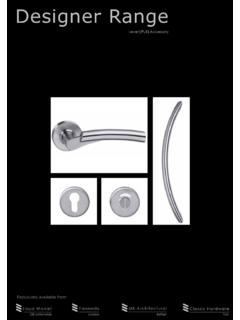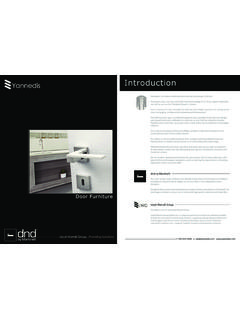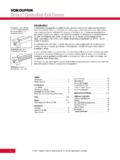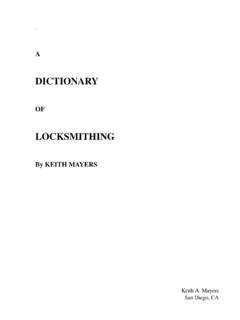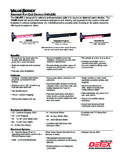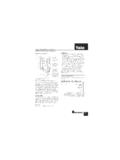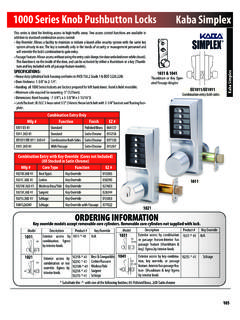Transcription of Locking Devices - Lloyd Worrall
1 Locking Devices Lockcases|Cylinders|Standards Llo yd Worrall Y an n e dis C lassic Hardwar e M B A r ch it ect ur al GB nationwide London York Belfast Technical Details BS EN 12209: 2003 Mechanically operated locks, latches and Locking plates. Products tested to British and European standards provide greater durability, longer warranty periods, peace of mind and evidence of professional specification. Under the standard each product is tested and classified accordingly to show its compliance. The identification of an 11-digit code is visible on the individual product. Each digit represents a category and how it measured against the standard to which it was tested. Digit 1: Category of use Digit 5: Safety 1 = Light use. For use by people with a high incentive to exercise Only 1 grade of safety is identified. care and with a small chance of misuse.
2 0 = no safety requirement. 2 = Normal use. For use by people with some incentive to exercise care but where there is some chance of misuse. Digit 6: Corrosion resistance and temperature 3 = Extreme use. For use by people where there is little incentive 0 = no defined corrosion resistance, no temperature requirement. to exercise care and where there is a high chance of misuse. A = low corrosion resistance, no temperature requirement. Digit 2: Durability B = moderate corrosion resistance, no temperature requirement. C = high corrosion resistance, no temperature requirement. A = 50,000 test cycles; no load on latch bolt. D = very high corrosion resistance, no temperature requirement. B = 100,000 test cycles; no load on latch bolt. E = moderate corrosion resistance, temperature requirement from C = 200,000 test cycles; no load on latch bolt.
3 -20 C to +18 C. F = 50,000 test cycles; 10 N load on latch bolt. F = high corrosion resistance, temperature requirement from -20 C G = 100,000 test cycles; 10 N load on latch bolt. to +18 C. H = 200,000 test cycles; 10 N load on latch bolt. G = very high corrosion resistance, temperature requirement from L = 100,000 test cycles; 25 N load on latch bolt. -20 C to +18 C. M = 200,000 test cycles; 25 N load on latch bolt. Digit 7: Security and drill resistance R = 100,000 test cycles; 50 N load on latch bolt. S = 200,000 test cycles; 50 N load on latch bolt. 1 = minimum security and no drill resistance. W = 100,000 test cycles; 120 N load on latch bolt. 2 = low security and no drill resistance. X = 200,000 test cycles; 120 N load on latch bolt. 3 = medium security and no drill resistance. Digit 3: Door mass and closing force 4 = high security and no drill resistance.
4 5 = high security with drill resistance. 1 = up to 100kg door mass; 50 N maximum closing force. 6 = very high security and no drill resistance. 2 = up to 200kg door mass; 50 N maximum closing force. 7 = very high security with drill resistance. 3 = above 200kg door mass or specified by the manufacturer; 50 N maximum closing force. Digit 8: Field of door application 4 = up to 100kg door mass; 25 N maximum closing force. 15 grades of door application are identified and summarised in the table 5 = up to 200kg door mass; 25 N maximum closing force. below: 6 = above 200kg door mass or specified by the manufacturer; 25 N maximum closing force. Grade Type Application 1 Application 2 Application 3. A Mortice Unrestricted application 7 = up to 100kg door mass; 15 N maximum closing force. B Mortice Hinged door 8 = up to 200kg door mass; 15 N maximum closing force.
5 C Mortice Sliding door 9 = above 200kg door mass or specified by the manufacturer; 15 D Rim Unrestricted application N maximum closing force. E Rim Hinged door F Rim Sliding door G Bored lock Unrestricted application Digit 4: Suitability for use on fire/smoke doors H Mortice Hinged door Supported J Rim Hinged door Inwards 0 = not approved for use on fire/smoke resisting door K Mortice Hinged door Locked from inside assemblies. L Mortice Sliding door Locked from inside M Rim Hinged door Locked from inside 1 = suitable for use on fire/smoke resisting assemblies, subject N Rim Sliding door Locked from inside to satisfactory assessment of the contribution of the lock P Mortice Hinged door Supported Locked from inside or latch to the fire resistance of specified fire/smoke resisting R Rim Hinged door Inwards Locked from inside door assemblies.
6 L lo yd Worra l l Yan n e d i s C la s s ic H a r d w a r e M B A r ch it ect ur al GB nationwide London York Belfast Technical Details BS EN 12209: 2003 Mechanically operated locks, latches and Locking plates. Digit 9: Type of key operation and Locking Marking: 0 = not applicable. The standard requires the following additional information to A = cylinder lock or latch, manually Locking . accompany the CE Marking required for locks and latches intended for use on fire resisting doors and smoke control doors. B = cylinder lock or latch, automatically Locking . C = cylinder lock or latch, manually Locking with intermediate a) The identification number of the notified certification body. Locking . b) The name or identifying mark of the manufacturer. D = lever lock or latch, manually Locking . c) The registered address of the manufacturer. E = lever lock or latch, automatically Locking .
7 D) The last two digits of the year in which the marking was F = lever lock or latch, manually Locking with intermediate Locking . applied. G = lock or latch without key operation, manually Locking . e) The number of the EC certificate of conformity, reference to H = lock without key operation, automatically Locking . EN 12209:2003. f ) The classification code of the product. Digit 10: Type of spindle operation 0 = lock or latch without follower. 1 = lock or latch for knob or sprung lever handle operation. 2 = lock or latch for unsprung lever handle operation. 3 = lock or latch for heavy duty unsprung lever handle operation. 4 = lock or latch for heavy duty unsprung lever handle operation specified by the manufacturer. Digit 11: Key identification requirement 0 = no requirements. A = minimum three detaining elements. B = minimum five detaining elements.
8 C = minimum five detaining elements, extended number of differs. D = minimum six detaining elements. E = minimum six detaining elements, extended number of effective differs. F = minimum seven detaining elements. G = minimum seven detaining elements extended number of effective differs. H = minimum eight detaining elements, extended number of effective differs. Example: 2 H 5 1 0 E 5 A F 2 C. The above code signifies a mechanically operated lock and Locking plate for use in an application where people have an incentive to exercise care, able to withstand a durability of 200,000 cycles with a 10 N load on the latch bolt, on a door with a mass of up to 200kg and a maximum closing force of 25N, suitable for use on a fire/smoke resisting door assembly, no safety requirement, moderate corrosion resistance in temperatures ranging from -20 C to +18 C, with high security and drill resistance for any use in any mortice application, with a manual Locking lever lock or latch unsprung lever handle operation, a minimum of five deadlocking elements and an extended number of effective differs.
9 L lo yd Worra l l Yan n e d i s C la s s ic H a r d w a r e M B A r ch it ect ur al GB nationwide London York Belfast Euro Locks 85. European lock case range produced to DIN standards 24 55. and dimensions, o ering reliable heavy duty locks in standard applications. All 55mm backset only. Single throw deadbolt locks are suitable for use with 235 150. unsprung lever handles. Investment casting of the followers and guided deadbolt mechanism make this a severe duty range. Available radius and square. Deadlock Sashlock Bathroom Lock IL001 IL002 IL003. Latch Escape Nightlatch Anti-thrust Escape Nightlatch IL004 IL005 IL006. Anti-panic Sashlock IL007. Finishes S t andards Reb ate Sets Satin stainless steel BS EN 12209 12mm and 25mm rebate sets are available. Polished brass Produced to DIN Standards and dimensions Llo yd Worrall Y an n e dis C lassic Hardwar e M B A r ch it ect ur al GB nationwide London York Belfast Versatile Locks A comprehensive series of locks giving standard 77.
10 And special applications. 57. Heavy duty high security Locking options. The same case accepts British oval and 110. European pr cylinders. Available with square 153. or radius forend. All locks come with boxed keeps. 16. Heavy Duty High Security Sashlock Deadlock Bathroom Lock Latch Deadbolt 30 x 11mm 20 mm throw Latchbolt throw IL010 IL011 IL012 IL013. HEAVY DUTY AUTO DEADLOCKING. Nightlatch Snib Holdback Nightlatch No Holdback Escape Nightlatch No Escape Nightlatch Holdback Snib Holdback IL014 IL015 IL016 IL017. Escape nightlatch non deadlocking version IL018. HEAVY DUTY HIGH SECURITY SPECIAL APPLICATION LO CKS. Escape Sashlock Escape Deadlock Internal lift lever to lock depress Internal lift lever to lock depress lever lever to withdraw latch and to unlock deadbolt simultaneously External lever operates latch bolt External cylinder operates deadbolt only, cylinder operates deadbolt Both locks must use single cylinders only IL019 IL020.

